How To Trim A Pine Tree Branches Without Killing It?
Pine trees require regular pruning. Begin with choosing a sharp, well-suited tool. Remove the dead branches, suckers, and work your way towards the lower branches. Finish up with shaping the tree.
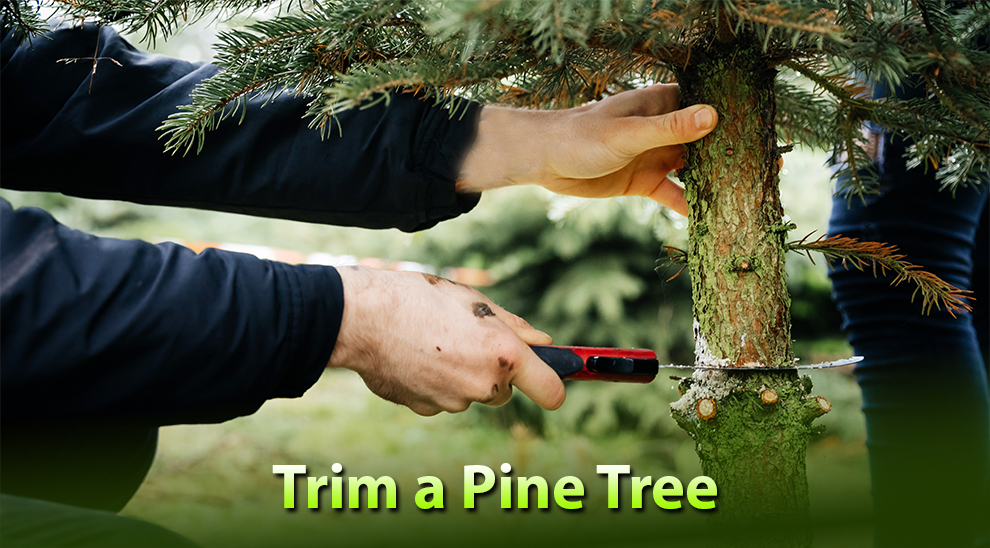
Pruning a pine tree is an essential task. It promotes its aesthetics, health, and overall growth.
But you must know how to trim a pine tree without killing it because an improper cutting can be fatal for the plant.
Hence, when it comes to trimming the pine trees, a top-down approach is particularly recommended making sure not to harm the crown. This method requires starting from the top and working your way downwards, symmetrically removing the diseased, damaged, and dead branching.
To commence the pruning process, you must have the necessary clean & sharpened tools, such as pruning saws, loopers, or shears. Before making any cuts, assess the tree and identify the branches that need pruning.
While removing the branch, locate the branch collar and the swollen area at the branch’s base. Make a clean cut outside the branch collar, avoiding cutting too close or leaving a stub.
Key Takeaway
- Select a pruning tool for pine tree
- Start by removing the dead branches
- Get rid of the suckers
- Work with the lower branches
- End by shaping the pine tree
Why Prune A Pine Tree?
Timely pruning helps promote fresh growth and lowers the susceptibility to infection. Beyond learning how to prune pine trees, it is also crucial to note that you must prune trees during the dormant season, especially in early spring or late winter.
Regular pruning also aids in maintaining the plant’s shape, controlling its size, and preventing the development of weak branches. Further, it amplifies the air circulation and lets more sunlight reach the tree’s inner parts, accentuating its appeal and vigor.
After removing the pruned branches, you accentuate your tree’s appearance and also reduce the risk of potential hazards, such as falling limbs.
When Should I Trim A Pine Tree (Best Time)?
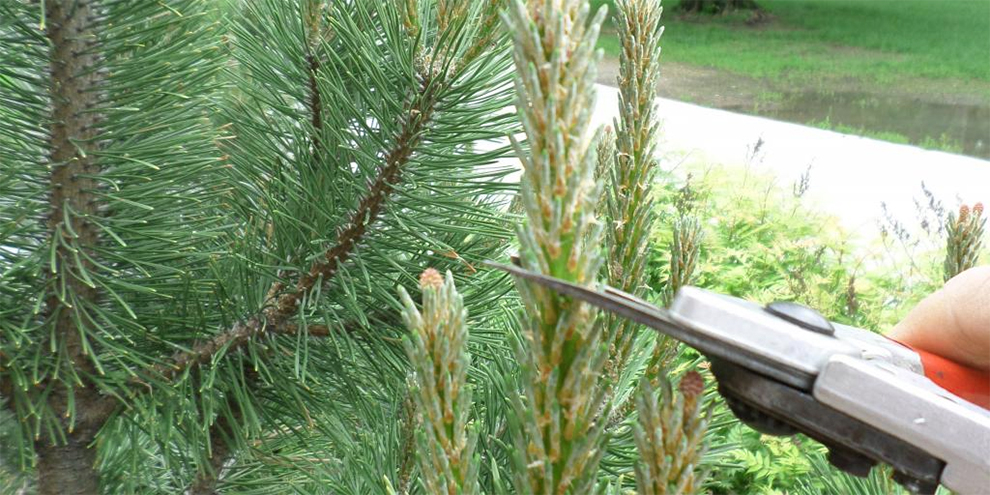
February is the best time to trim the pine trees because:
- It falls within the dormant season for most pine tree species. During this time, the tree is in a reduced growth phase. Hence, it is an ideal time to prune. Pruning during dormancy reduces stress on the trees and lets them allocate resources more effectively for regrowth and healing.
- Insects and diseases that typically affect pine trees are usually less active in the dormant season. Hence, pruning in February lowers the risk of spreading diseases or attracting pests that can harm the trees. The cooler temperature also discourages the spread and growth of some pathogens.
- Pruning cuts on pine trees generally heal better during the dormant season. The tree’s energy is typically focused on crown and root development instead of producing new growth, letting it allocate the resources to wound closure and recovery.
- During this time, the pine tree does not have foliage. Hence, the pine tree branch structure is better visible. This improved visibility allows better assessment and strategic pruning decisions. You can determine the damaged, dead, or diseased leaves and areas where shaping or thinning is necessary.
What Is Candle Pruning?
Cutting the tree from the top down is candle pruning. It is done in spring before new growth elongates fully. Here are the steps for cutting pine trees from the top down:
- Assess the tree, select sharp tools, and identify candles (new shoots at branch tips).
- Cut candles by one-half or one-third above lateral buds or needles to encourage branching.
- Repeat annually to manage height and density.
- Monitor the tree for stress or disease.
- Consult an arborist if unsure or dealing with a large tree.
How To Trim A Pine Tree That Is Too Tall?
To trim a tall pine tree, follow these general guidelines:
A. Decide What Is The Best Tool To Trim Pine Trees?
First of all, you need to pick the correct tool for pruning as per the size of your tree. The best tools for trimming pine trees are:
1. Pruning shears, hand pruners, or secateurs: These tools help cut smaller branches (up to 1 inch in diameter) with precision. Opt for a bypass pruner for cleaner cuts.
2. Loopers:These have larger blades and long handles, letting you cut branches with 1 to 2 inches diameter. Loopers give more leverage and reach than pruning shears.
3. Pruning Saw: It has a straight or curved blade that cuts thicker branches seamlessly. You can use it for branches over 2 inches in diameter.
4. Pole pruner: If you wish to trim higher branches, use a pole saw or pole pruner. It has a looper or saw annexed to an extendable pool, letting you reach and cut branches from the ground.
When picking the tools, select sharp and well-maintained pruners apt for the branch’s thickness and size. You must clean and disinfect the tools before and after use to avoid the disease spread.
B. Begin With Removing The Dead Branches
To trim the pine tree, start by removing the dead branches. Dead branches are unsightly and pose a risk if they fall. Here are the steps on how to cut a pine tree’s dead branches:
1. Inspect the tree: Carefully examine the pine tree to identify the dead branches. Dead branches lack needles and do not show signs of growth.
2. Pick the correct tools: From the ones stated above, pick the most suited tool. Ensure the tools are sharp and clean for seamless cutting.
3. Cut at the branch collar: Locate the branch collar, the bulged area where the branch connects to the bigger branch or trunk. Now make a clean cut outside the branch collar without leaving a stub. Cutting too close to the collar may damage the trunk, while leaving a stub may hinder proper healing.
4. Dispose of the branches: Gather all the removed dead branches and dispose of them appropriately. You can compost them if possible or contact local authorities for proper disposal methods.
5. Repeat the process: Inspect the tree regularly and remove any remaining dead branches across the canopy.
Be cautious of your safety as you work with the tools at heights. If the dead branches are located high up, consider hiring a professional arborist experienced in working with tall trees.
C. Remove The Suckers
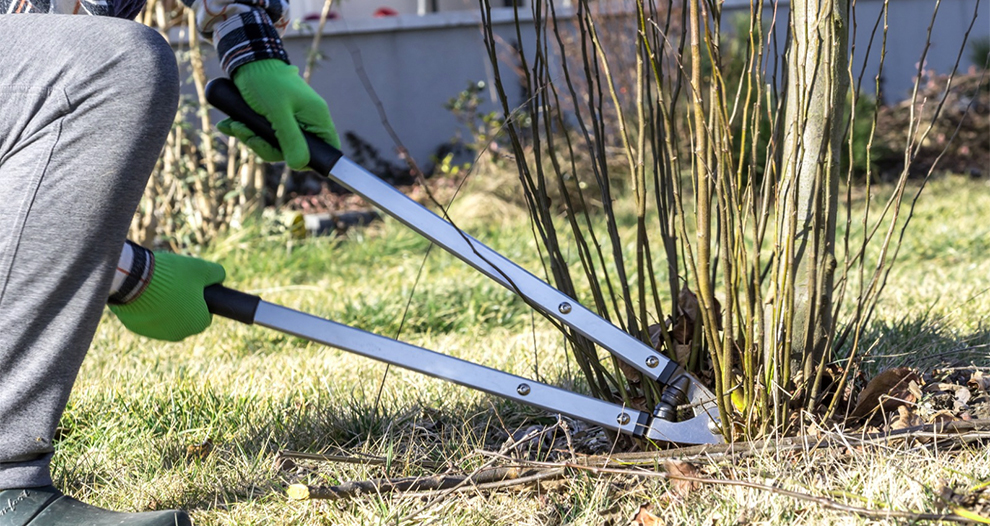
Once you remove the dead branches, the next step is removing the shuckers. These weak, small shoots grow from the tree’s base or lower parts.
Removing suckers helps maintain the tree’s appearance, prevents the diversion of energy away from the main branches, and promotes better overall growth.
Here is how you can do it:
1. Identify the suckers: Examine the tree and look for all vertical, thin shoots emerging from the pine tree’s base or the lower branches or trunk.
2. Pick the apt tools: You can use loopers and pruning shears for the shuckers, provided they are sharp and clean for precise cuts.
3. Start at the base: Position your pruning tool just above the plant, where the shucker originates from the branch or trunk. Make an angled, clean cut as close to the base as possible without damaging the surrounding trunk tissue or bark.
4. Dispose of the removed suckers: Gather all the cut suckers and dispose of them properly.
5. Monitor regularly: Suckers may regrow, particularly if the root system is disturbed or the tree is stressed. Keep a check.
D. Pruning Pine Trees’ Lower Branches
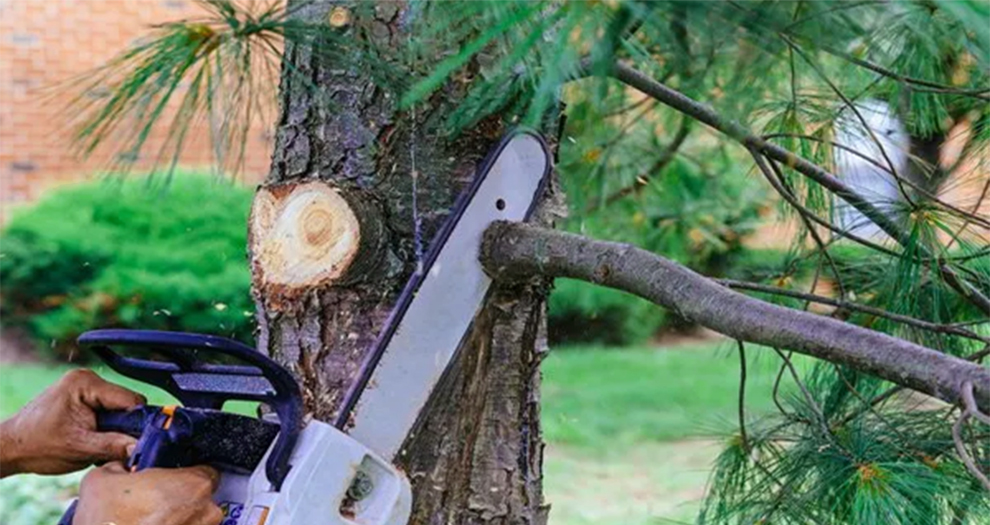
Pruning lower branches helps improve visibility, creates clearance for vehicles or pedestrians, and accentuates overall aesthetics.
Here is how to trim pine tree branches at the lower end:
- Assess the tree to see which lower branches need pruning. Consider the overall shape, balance, and clearance height to decide.
- Depending on the branch’s thickness and size, you can use clean and sharp pruning saws, loopers, or pruning shears.
- Start by pruning the lowest branches and work your way up. It helps maintain stability and ensures seamless access to the tree’s lower parts.
- Identify the collar branch and make a clean cut just outside the branch collar, avoiding cutting too close or leaving a stub.
- While handling the lower branches, you must only tackle them gradually over time instead of cutting them altogether. It helps minimize tree stress and ensures proper healing.
- Monitor the lower branch growth and trim, as needed, to maintain the shape and aesthetics.
E. Shaping The Pine Tree
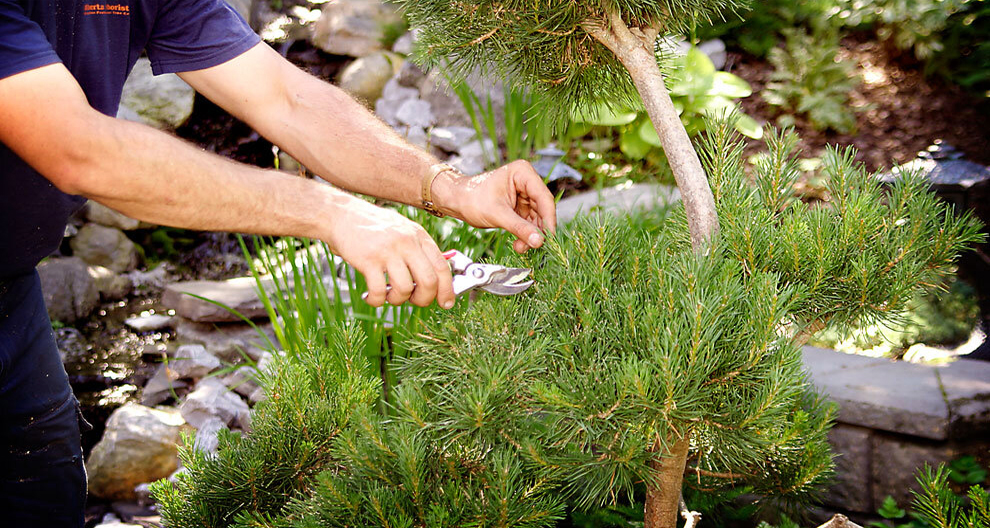
Shaping the pine tree via pruning can help maintain its desired form, accentuate its visual appeal, and encourage balanced growth. Here are the steps:
- Determine the desired shape you wish to achieve, considering the aesthetic goals you have in mind, the surrounding landscape, and their natural growth habit.
- Assess the tree: Evaluate the tree’s current structure and identify the branches that require shaping or adjustment. Look for branches growing too close together, crossing, or intervening with the desired shape.
- Prune for shape: Remove or trim branches that deviate from the desired shape. Make clean cuts outside the branch collar, considering the tree’s natural growth pattern and overall aesthetics.
- Maintain symmetry: Aim for a symmetrical shape, ensuring the pruning on one side mirrors the adjustments on the tree’s other side for a pleasing visual appearance.
- Step back and evaluate: Periodically step back to assess your progress and make amends as necessary to maintain the desired shape and overall health.
You might also like to know about how fast a pine tree grows.
How To Trim A Pine Tree That Is Too Wide?
Follow the steps to prune the pine tree that is too wide:
- Assess the tree to evaluate its overall width and shape to identify the branches that contribute to excessive width and need pruning.
- Determine the desired widthyou wish to achieve, considering the tree’s natural growth habit, available space, and aesthetic preferences.
- Pick the correct tools based on the thickness and size of the branches you trim.
- Start with outer branches that contribute to the tree’s width and look for branches that extend beyond the desired width and those that intervene or cross with nearby plants or structures.
- Make thinning cuts over heading cuts to maintain the tree’s natural form while reducing the width.
- Maintain a symmetrical and balanced appearance by trimming on both sides to maintain a pleasing shade as you reduce the width.
- Step back and assess regularly to evaluate the progress and ensure you have achieved the desired width. Make adjustments as needed.
- Prune gradually over multiple years if the width is significantly excessive because removing too many branches at once can stress the tree.
Can You Cut The Top Of A Pine Tree?
Even though it is technically possible, we do not recommend cutting the pine tree’s top. Removing the top portion or hatracking or topping has significant negative consequences because:
- It can severely damage or stress the tree.
- The tree may respond to top cuts by producing numerous weak and poorly attached new branches called water sprouts that are susceptible to breakage, comprising the tree’s overall structure and integrity.
- Wounds from topping create openings for insects, pathogens, and decay organisms to enter the tree, increasing the risk of disease and infestation. It can lead to further decline and damage over time.
- Topping leads to an unsightly and unnatural appearance, disrupting the tree’s growth. The tree can take many years to return to its original shape.
Related: Small Indoor Pine Trees
When & How To Prune Pine Bonsai?
Typically, you prune pine bonsais in early spring or late winter, just before the new growth shows. This time helps the tree recover faster and promotes healthy development. Follow the steps below to prune the pine bonsais:
- Choose the correct tools, such as bonsai scissors or pruning shears, to make precise cuts without damaging branches.
- Remove branches that disrupt the desired shape or detract from the bonsai aesthetics. Always cut to the origin point or remove them entirely.
- Trim or pinch the branch tips to stimulate the growth of the side shoots and create a fuller or more compact appearance.
- Maintain balance by evenly distributing the branches around the trunk, ensuring no one side is overly dominant.
- While pruning is necessary, do not remove too much foliage at once. Gradual and selective pruning can help maintain the tree’s vitality and health.
Signs That Your Pine Tree Needs Pruning.
Here are some signs that indicate your pine tree needs pruning:
- Branch overlapping
- Dense foliage curtailing air circulation and sun penetration.
- Dead or diseased branches
- Weak or drooping branches
- Stunted or yellowing growth
- Overgrown tree moving out of its designated space
- Aesthetic reasons
Do Pine Trees Grow Back If You Cut Them?
Yes, pine trees can regrow and recover after being cut or pruned. However, the extent of their regrowth and the time it takes for full recovery can vary depending on several factors.
It includes the pine species tree size, the pruning technique used, and the tree’s overall health. Pine trees have a long lifespan and can generate new growth from dormant buds along the branches or trunk if cautiously pruned.
These buds can produce new branches and needles, allowing the tree to regain shape and vitality. However, it is essential to note that excessive or improper pruning can weaken the tree and hinder its ability to recover effectively.
Related: Types of White Pines | Blue Pine Varieties | Mugo Pine Types | Longleaf Pine Trees
Quick Tips On How To Prune Pine Trees
- Do not prune over 25 percent of the foliagein a go, as excessive pruning weakens the tree and affects its overall health and vigor.
- Understand the specific growth habits of your pine tree, as some pines have a more open and spreading habit, while others are more upright. Consider these growth habits when shaping the tree to maintain its overall appearance.
- Maintain the central leader or the dominant vertical stem when shaping the tree, and prune any competing branches that inhibit the main leader’s growth.
- Prioritize thinning cuts over heading cuts: The former involves removing the entire back to its point of origin while heading cuts involve cutting back a portion of a branch. Thinning cuts help maintain the tree’s natural form and structure.
- Inspect for pests and diseases, such as fungal infections or bark beetles, and promptly address the issues to prevent further damage.
- Seek professional help if needed
